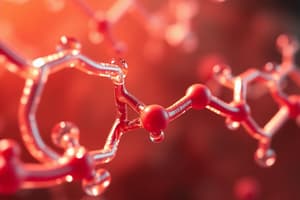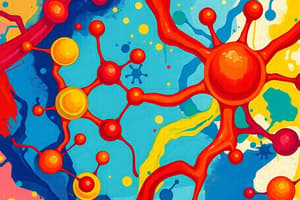Podcast
Questions and Answers
What role do metal ions play in enzyme activity?
What role do metal ions play in enzyme activity?
- They increase the activation energy of reactions.
- They stabilize negative charges in intermediates. (correct)
- They act as substrates.
- They inhibit the enzyme activity.
Proteases cleave peptide bonds by a process that is thermodynamically unfavorable.
Proteases cleave peptide bonds by a process that is thermodynamically unfavorable.
False (B)
What is the term used for the bond cleaved by proteases?
What is the term used for the bond cleaved by proteases?
scissile bond
Enzymes speed up reactions by reducing _____
Enzymes speed up reactions by reducing _____
Match the following terms with their definitions:
Match the following terms with their definitions:
Which class of protease utilizes a Ser residue as a nucleophile?
Which class of protease utilizes a Ser residue as a nucleophile?
Chymotrypsin primarily hydrolyzes peptide bonds on the carbonyl side of large hydrophobic amino acids.
Chymotrypsin primarily hydrolyzes peptide bonds on the carbonyl side of large hydrophobic amino acids.
What is the role of Ser 195 in chymotrypsin?
What is the role of Ser 195 in chymotrypsin?
Cysteine proteases contain a ______ residue in their active site whose thiol group acts as a nucleophile.
Cysteine proteases contain a ______ residue in their active site whose thiol group acts as a nucleophile.
Match the following classes of proteases with their defining feature:
Match the following classes of proteases with their defining feature:
Flashcards are hidden until you start studying
Study Notes
Enzyme Catalysis
-
Enzymes utilize a range of catalytic strategies beyond simply providing energy for reactions.
-
Metal Ion Catalysis:
- Metal ions can facilitate nucleophile formation by coordinating with the nucleophile.
- Metal ions can stabilize negative charges by acting as electrophiles.
- Metal ions can bridge substrates and enzymes to hold them in optimal conformation for catalysis.
- Example: Carbonic Anhydrase
-
Catalysis by Approximation:
- Enzymes can bring substrates together on a single binding surface in a way that facilitates catalysis.
- Example: Carbonic Anhydrase
Proteases
- Proteases: Enzymes that cleave peptide bonds through hydrolysis.
- Peptide bond hydrolysis is thermodynamically favorable but kinetically slow due to the planar nature of the peptide bond.
- Proteases accelerate the process by reducing the activation energy (ΔG‡).
- Specificity Nomenclature:
- Scissile Bond: The bond that is cleaved.
- Residues: Numbered from the scissile bond outward.
- Peptide Substrate:
- Residues on the N-terminus side are labeled P1, P2, P3…
- Residues on the C-terminus side are labeled P1’, P2’, P3’…
- Binding Sites on the Enzyme: Labeled S and S’.
Four Classes of Proteases
- Despite their diversity, all classes of proteases share a similar catalytic strategy: generating a powerful nucleophile to attack the carbonyl moiety in a peptide bond.
- Serine Proteases: Utilize a Ser residue in their active site. Its hydroxyl group acts as a nucleophile.
- Cysteine Proteases: Utilize a Cys residue in their active site. Its thiol group acts as a nucleophile.
- Aspartyl Proteases: Employ an Asp residue to activate a water molecule.
- Metalloproteases: Contain a metal ion that activates a complexed water molecule.
Chymotrypsin: A Serine Protease
- Chymotrypsin is a serine protease. Its catalytic mechanism can be demonstrated using a group-specific reagent called DIPF (Diisopropyl fluorophosphate).
- Chymotrypsin has 28 serine residues, but only Ser195 reacts with DIPF.
- When Ser195 is modified, chymotrypsin loses all activity, indicating its crucial role in catalysis.
Specificity of Chymotrypsin
- Chymotrypsin exhibits specificity for cleaving peptide bonds after large hydrophobic amino acids (Phe, Tyr, Trp, Met).
- The specificity arises from the S1 pocket in chymotrypsin, which is lined with hydrophobic residues, favoring the binding of large hydrophobic side chains.
- Chymotrypsin preferentially cleaves peptide bonds on the carbonyl side of aromatic or large hydrophobic amino acids.
- Ser195 is positioned to directly cleave after the residue located in the S1 pocket.
Catalytic Mechanism of Chymotrypsin
- Chymotrypsin's catalytic design relies on the Asp-His-Ser catalytic triad.
- The mechanism involves the formation of a covalent intermediate.
- The oxyanion hole stabilizes the tetrahedral intermediate.
Carbonic Anhydrase: A Metal Ion Catalysis Example
- Carbonic anhydrase catalyzes the reversible conversion of carbon dioxide (CO2) to bicarbonate (HCO3-).
- The enzyme enhances the rate of this reaction, operating at diffusion limits.
- Active site of carbonic anhydrase II: Contains a Zn2+ ion coordinated to the imidazole rings of three histidine residues and to one water molecule.
Proposed Mechanism of Carbonic Anhydrase
-
- Water binds to Zn2+, reducing its pKa from 15.7 to 7.
-
- The Zn2+ increases the acidity of the proton on water, making it easier to generate a hydroxide ion (a more potent nucleophile).
-
- A hydrophobic patch near the zinc site allows CO2 to bind, positioning it for attack by the Zn-bound OH-.
-
- The OH- attacks CO2, converting it to bicarbonate.
-
- The active site regenerates upon release of HCO3- and binding of H2O.
Metal Ion Catalysis in Carbonic Anhydrase
- The Zn2+ ion's interaction with water leads to the formation of a more stable transition state.
- The pKa of water is lowered, making proton release easier.
- This mechanism exemplifies metal ion catalysis.
- Catalysis by approximation: The water molecule is positioned in close proximity to CO2.
Histidine Proton Shuttle in Carbonic Anhydrase
-
- The zinc-bound water molecule needs to lose a proton to initiate hydration. His64 picks up the proton from the zinc-bound water, generating the hydroxide ion and protonated histidine.
-
- To avoid reprotonation of the OH- and regenerate unprotonated His, a buffer molecule removes a proton from histidine.
- The His serves as a proton shuttle, transferring the proton from water to the buffer.
Buffer Concentration and CO2 Hydration Rate
- Increasing buffer concentration enhances the rate of CO2 hydration.
- Buffers are crucial for the reaction mechanism. The proton shuttle transfers protons from the zinc-bound water molecule to the protein surface via His64, and then to the buffer.
- Buffers are too large to access the active site directly, requiring the His shuttle.
Studying That Suits You
Use AI to generate personalized quizzes and flashcards to suit your learning preferences.




